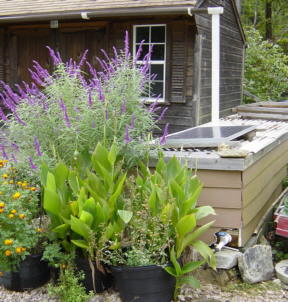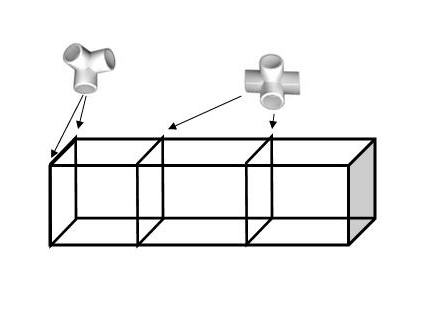|
Rain Water Harvesting
We have a 75 gal rain barrel at each corner of the house. The overflow from the rain barrel receiving the most water goes into a 30 gal tub. In the tub is a float-activated sump pump connected to a 3/4 inch, 75 ft long hose. When the tub is full, the float rises up and turns on the pump. The water is pumped to one of three places determined by where we put the end of the hose.
The most frequently used place is two large stock tanks that are linked together. These tanks sit on top of a hill and have an underground pipe running to a faucet in the garden. The faucet is really a one-inch gate valve, used because it allows greater water flow than a traditional outdoor faucet. Most brass outdoor faucets have built-in flow restrictors to keep people from wasting water. On our gate valve is a good quality Y-connector with individual shut offs. One side of the Y has a PVC pipe elbow aimed down for filling buckets. The other side of the Y has a threaded hose connector with an in-line filter with fine nylon mesh screen attached. With this set-up, there is sufficient pressure to run soaker hoses. The addition of the stock tanks and faucet with the Y-fitting has made watering the garden and greenhouse so much easier.
When the tanks are full, the hose is run to a 700 gal reservoir that Hugh and I built. The reservoir is about 17 ft long, 3 ft wide and 2 ft deep. See picture below. We used PVC pipe with 3- and 4-way connectors purchased from Peaceful Valley Farm Supply (diagram below). Hugh didn't think we needed to put screws in to hold the connectors onto the pipes. We have since had to take things apart and put the screws in. Water is very heavy. The pipe frame is lined with a swimming pool cover (thick, sturdy bubble plastic) that we found at the dump and then with 5 mil black polyethylene sheeting. We have siding on the outside that is painted brown. The lid is a simple 1 x 3 cedar board frame covered with fiberglass window screen. On top of the screen is corrugated plastic sheeting used for covering patios. In the lower corner is a bulk head fitting with a gate valve attached. We don't have a Y on this one because we mostly use it to fill watering cans and buckets. The reservoir is positioned alongside a shed. The downspouts from the shed run into the reservoir.
When the stock tanks are drained during a drought, we run a hose from the reservoir to the tub with the sump pump. The hose connected to the sump pump is run up to the stock tanks. (I tried to use the sump pump directly with the soaker hoses. It didn't work. The sump pump is designed to pump water quickly.)
When both the reservoir and the stock tanks are full, we run the hose to a dry stream that runs down the hill to the pond. The pond also receives rain water via a hose from a rain barrel on the opposite side of the house.
If you want specific details for use in your garden, contact us. greta@gretasgarden.com We are happy to help out.
 
|